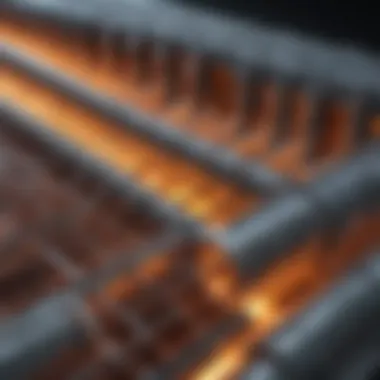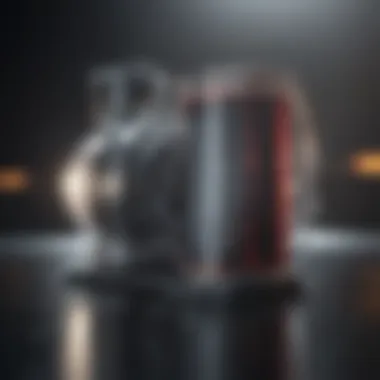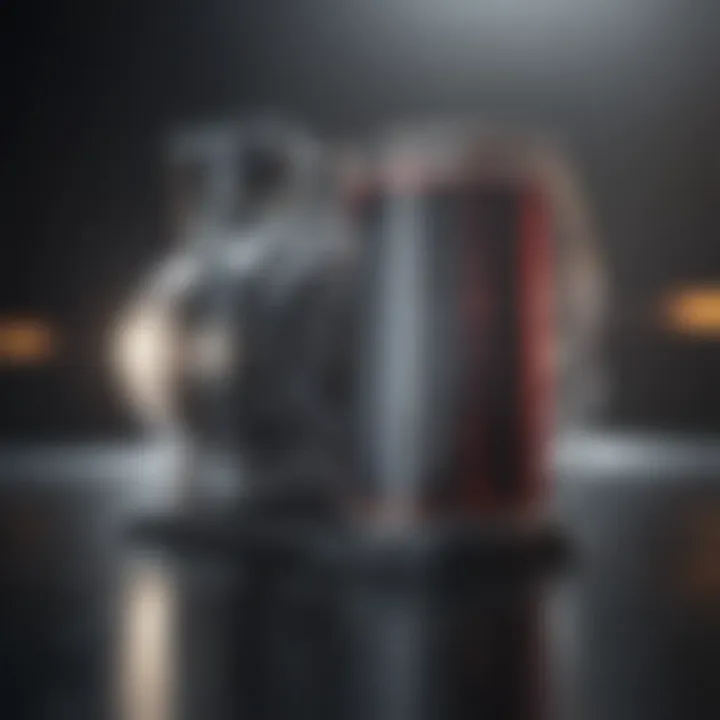In-Depth Analysis of Battery Separator Films


Article Overview
The realm of battery technology necessitates a robust understanding of components that enhance both efficiency and safety. At the heart of lithium-ion batteries lies a crucial element known as the battery separator film. This article will delve into the significant role these films play, examining their composition, properties, and the advancements in technology that influence their performance. We will sift through the nuances surrounding separator films, unpacking their impact on battery efficacy and longevity.
Purpose of the Article
The main objective of this examination is to shed light on the various intricacies surrounding battery separator films, pinpointing their contributions to the functionality and safety of modern energy storage systems. By dissecting the materials used, one can appreciate how these films help keep battery components separate while preventing short circuits, thus enhancing battery life. This overview is essential for anyone invested in the battery sector, from manufacturers to researchers.
Relevance to Multiple Disciplines
Battery separator films intersect with a multitude of disciplines, including chemistry, materials science, and electrical engineering. Understanding how these films affect energy storage delves into:
- Chemical Composition: The materials that comprise separator films dictate their thermal and chemical stability.
- Electrical Engineering: The effectiveness of these films directly influences battery performance, making profitable contributions to consumer electronics, electric vehicles, and renewable energy systems.
Thus, insights gained from this article can resonate well across multiple fields, offering essential knowledge for academics, professionals, and enthusiasts alike.
Research Background
To fully grasp the role of battery separator films, it is beneficial to explore their historical context along with some foundational concepts.
Historical Context
Historically, battery development has gone through several iterations, particularly with the evolution of lithium-ion technology. In the early days, challenges mainly hinged on finding a suitable material that could withstand chemical reactions while maintaining effective performance. Only since the 1990s has there been significant refinement in separator film technology, leading to the advanced options we utilize today. The transition from traditional materials like paper to polymer-based membranes marked a pivotal moment in battery innovation.
Key Concepts and Definitions
- Battery Separator Film: A thin layer present in batteries that acts as a barrier between cathode and anode, preventing internal short circuits while allowing ion transfer.
- Thermal Stability: The ability of the separator material to resist degradation under high temperature, essential for safety.
- Ion Conductivity: Refers to how effectively ions can pass through the separator, which directly correlates with battery efficiency.
These terms build a foundation for understanding how innovations in battery separator films have driven advancements in energy storage technologies.
"Battery separators are like the unsung heroes of energy storage, working quietly behind the scenes to ensure safety and efficiency."
"Battery separators are like the unsung heroes of energy storage, working quietly behind the scenes to ensure safety and efficiency."
As this article unfolds, we will delve deeper into the specific materials and properties that differentiate separator films, along with recent technological strides and future challenges in the industry.
Intro to Battery Separator Films
In the rapidly advancing world of energy storage, battery separator films stand as an unsung hero. They play a pivotal role in ensuring that batteries, particularly lithium-ion types, operate efficiently and safely. This section serves to outline what battery separator films are and why they are essential in modern batteries.
Definition and Functionality
Battery separator films are thin membranes placed between the anode and cathode of a battery. These non-conductive materials serve as a barrier, preventing short circuits while allowing the flow of ions.
Their primary function is twofold:
- Electrical Insulation: The separator stops unwanted contact between the positively and negatively charged electrodes, which is crucial for battery safety.
- Ionic Transport Facilitation: While blocking electrons, they enable lithium ions to move freely between the electrodes during charging and discharging cycles.
This dual functionality is fundamental to the performance, longevity, and safety of batteries. A well-designed separator allows for high ionic conductivity while making certain that the electrons stay where they belong during operation.
Historical Context
The development of battery separator films has a rich history, intertwined with the evolution of battery technology itself. Early batteries used simple cloth or paper as separators, which, while effective to some extent, presented several problems including limited durability and high susceptibility to degradation under operational stress.
As science progressed, the introduction of polymeric materials marked a turning point. Polyethylene, for example, became a popular choice due to its excellent ionic conductivity and thermal stability. Over the years, innovators in material science have increasingly focused on combining various materials to enhance separator properties. Today, separators are made from advanced composites and nanostructured materials that deliver improved safety and performance metrics.
This evolution is significant as it reflects the ongoing commitment to optimizing energy storage solutions, particularly in the context of clean energy transitions and the growing demand for sustainable technologies.
This evolution is significant as it reflects the ongoing commitment to optimizing energy storage solutions, particularly in the context of clean energy transitions and the growing demand for sustainable technologies.
In summary, the journey of battery separator films from rudimentary cloth barriers to sophisticated, engineered materials highlights their integral role in the functionality of modern batteries. Understanding their definition and historical context sheds light on their current standing in the energy storage landscape, paving the way for discussions on materials, properties, and technologies in subsequent sections.
Materials Used in Battery Separator Films
Exploring the materials used in battery separator films is pivotal to understand their practicalities and overall performance. The selection of materials can significantly affect the efficiency, durability, and safety of lithium-ion batteries. Generally speaking, the right materials contribute not just to functionality but also to the cost-effectiveness of production. A mix of different materials can yield unique properties, enhancing the separator’s capabilities for various applications.
Polymeric Materials
Polymeric materials are the backbone of battery separator films. These substrates often exhibit excellent flexibility and can be engineered to achieve various thicknesses. Polyethylene (PE) and polypropylene (PP) are the two most common polymers utilized. Their chemical stability makes them suitable for blocking undesired interactions between the cathode and anode while permitting ionic movement.
A crucial aspect of polymer separators is their porosity that allows ions to flow freely, which is essential for battery functionality. However, the trade-off here is thermal stability. During extended use, high temperatures can make these materials prone to shrinking or melting—issues that can lead to short circuits.
Properties to consider when assessing polymeric materials include:
- Thickness: Affects ionic conductivity and overall battery efficiency.
- Porosity: Higher porosity may enhance ionic transport but can sacrifice mechanical strength.
Ceramic Coatings
Ceramic coatings have emerged as a game changer in battery separator technology. These coatings can be applied to polymeric substrates to improve their thermal stability and mechanical integrity. Unlike pure polymers, ceramics can withstand higher temperatures without degradation, which becomes increasingly critical in high-energy applications.


Most commonly used ceramics include alumina and silica. They enhance not only thermal properties but also improve the separator’s resistance to puncture. By offering a barrier against lithium dendrites—a major cause of battery failure—ceramic-coated separators add a level of safety that is often non-negotiable in applications where reliability is paramount.
When working with ceramic materials, it’s important to weigh:
- Cost vs. Benefit: While they enhance properties, they can increase production costs.
- Adhesion: Ensuring proper bonding between ceramic and polymer is crucial for optimal performance.
Nanostructured Materials
Recent advancements in nanotechnology have naturally filtered into the realm of battery separators. Nanostructured materials, like graphene and carbon nanotubes, promise superior mechanical properties and enhanced ionic conductivity. This class of materials enables thinner films without compromising on performance, paving the way for lighter batteries with higher energy densities.
Furthermore, incorporating nanomaterials can lead to a synergistic effect when paired with traditional materials. For instance, adding a few percent of carbon nanotubes to a polymer matrix can significantly bolster both thermal and mechanical properties.
Some points worth noting about nanostructured materials are:
- Scalability: Manufacturing techniques need to be viable for mass production.
- Environmental Impact: The long-term safety and environmental implications of nanomaterials still need thorough investigation.
The variety of materials employed in battery separator films is a testament to the complexities of energy storage solutions today. A well-chosen mix of polymers, ceramics, and nanostructured materials can yield separators that not only enhance battery performance but also contribute greatly to safety and longevity.
The variety of materials employed in battery separator films is a testament to the complexities of energy storage solutions today. A well-chosen mix of polymers, ceramics, and nanostructured materials can yield separators that not only enhance battery performance but also contribute greatly to safety and longevity.
Key Properties of Separator Films
Battery separator films are much more than just barriers in manufactured batteries. They define the efficiency, safety, and longevity of these energy storage systems. The adeptness of a separator film directly influences how well a battery operates under varying conditions. Therefore, understanding the key properties of these films is paramount. In this section, we shall look into three critical attributes: thermal stability, ionic conductivity, and mechanical strength. Each one plays a significant role in the functionality of lithium-ion batteries.
Thermal Stability
The ability of a separator film to withstand high temperatures without degrading is what we refer to as thermal stability. In common situations, heat generation can occur during battery operation, particularly when they are being charged or discharged rapidly. When the temperature rises, a separator that lacks thermal stability can begin to break down, leading to potential short circuits and even thermal runaway situations.
Thermal stability becomes essential as it ensures safe operation even in demanding conditions. For instance, if a battery is subjected to excessive heat, a stable separator film will continue to provide insulation between the anode and cathode, mitigating risks. Materials like polyethylene and polypropylene are often chosen for their thermal resistance. Here's a quick breakdown on why thermal stability matters:
- Safety: Prevents short circuits.
- Performance: Maintains ionic conductivity at varied temperatures.
- Longevity: Extends the lifespan of the entire battery system.
"Thermal stability in separator films can be the difference between a functional battery and a potential hazard."
"Thermal stability in separator films can be the difference between a functional battery and a potential hazard."
Ionic Conductivity
When we talk of ionic conductivity, we're referring to a separator's ability to allow the easy passage of lithium ions between the anode and cathode. This property is pivotal for faster charging and discharging rates in batteries. High ionic conductivity correlates with improved battery performance, allowing devices to function efficiently.
In practice, separator films that exhibit high ionic conductivity can dramatically influence power output. For example, a separator that allows for quicker ion transfer will enable faster charging cycles, thus catering to applications like electric vehicles, which require rapid energy replenishment.
Important factors impacting ionic conductivity include:
- Material composition: Some polymer blends inherently enable better ion movement.
- Porosity: Enhanced porosity often equates to better conductivity without sacrificing mechanical strength.
- Temperature: How ionic conductivity varies with temperature is vital for performance in real-world usage.
Mechanical Strength
Mechanical strength pertains to a separator film's ability to withstand physical stress during battery operation. This includes factors like puncture resistance and tensile strength. A separator that lacks sufficient mechanical strength is vulnerable to tears and punctures, which can lead to catastrophic failures in a battery. Think of it as a dam holding back water; the stronger the dam, the less likely it is to break under pressure.
Battery separator films need to remain intact throughout the cycle of charge and discharge. Key points on mechanical strength include:
- Durability: Stronger films are less likely to suffer damage during manufacturing and operational use.
- Consistency: Films must maintain performance over extended periods, resisting fatigue.
- Integration: How the separator fits within the broader battery architecture needs careful consideration to avoid stress accumulation.
Impact on Battery Performance
When thinking about battery performance, the role of separator films cannot be overstated. These films act as the unsung heroes of lithium-ion batteries, ensuring longevity and safety while optimizing performance. The intricacies of how these films impact battery operation encompasses various elements, including cycle life, charge and discharge rates, and safety concerns. The significance of these aspects has grown in recent times, especially as energy demands increase and technologies evolve.
Cycle Life and Capacity
Cycle life refers to the number of charge and discharge cycles a battery can endure before its capacity significantly diminishes. The separator film plays a crucial role in determining the cycle life of the battery. A high-quality separator minimizes dendrite formation, which can lead to short circuits and rapid degradation.
- Material Quality: Using advanced polymeric materials has shown to improve cycle stability by resisting wear and tear during repetitive charge cycles.
- Thickness and Porosity: Films that are too thick can hinder ionic movement, while those that are too thin might compromise mechanical strength.
- Temperature Stability: The performance of these films under varying temperatures is a topic of active research. High thermal stability ensures the separator doesn’t shrink or deform during operation, which enhances the battery’s overall cycle life.
The interplay between these factors creates a delicate balance. An effective separator can reportedly extend cycle life by up to 50%, making it a vital consideration for manufacturers aiming to optimize battery performance.
Charge and Discharge Rates
The rate at which a battery can be charged and discharged is another cornerstone of its performance. Faster charge rates are desirable but can lead to overheating or reduced lifespan if not managed properly. Here, the separator film once more plays a pivotal role.
- Ionic Conductivity: A separator with higher ionic conductivity allows for quicker lithium ion movement. This is essential for both charging and discharging phases.
- Thermal Management: Films need to be designed to dissipate heat effectively; if they get too hot, it can lead to catastrophic failures.
- Compatibility with Electrolytes: Some separators are engineered to work synergistically with certain electrolytes, improving overall performance.
Effectively designed separator films allow batteries to achieve near-instant charge capabilities without sacrificing safety, which is a winning combination.
Safety Concerns
Safety cannot be overlooked when discussing battery performance. Separator films serve as barriers that prevent direct contact between the anode and cathode, mitigating the risk of short circuits and thermal runaway. Safety concerns include:
- Dendrite Penetration: Dendrites, which are tiny, needle-like structures, can grow through the separator films if they are not properly designed. This can lead to short-circuit scenarios.
- Chemical Stability: Some separators are susceptible to chemical reactions with the battery’s electrolyte, which can degrade their integrity over time.
- Thermal Stability: When exposed to high temperatures, some separators may become more prone to failure. Research is ongoing to develop films that maintain their integrity at elevated temperatures, thus enhancing battery safety.


In summary, the design and selection of separator films are essential not just for performance but also for ensuring the safety and longevity of battery systems. The continued advancements in materials science and technology promise to address these challenges, paving the way for safer and more efficient energy storage solutions.
"The separator film serves as the silent guardian of battery performance, ensuring both efficiency and safety amidst complex chemical interactions."
"The separator film serves as the silent guardian of battery performance, ensuring both efficiency and safety amidst complex chemical interactions."
By focusing on these pivotal elements, stakeholders can make informed decisions that enhance battery systems while addressing performance and safety concerns.
Separator Film Technologies
The evolution of battery technologies hinges on advancements in separator films. These films serve a vital function in maintaining the safety and efficiency of batteries. They act as barriers between the anode and cathode, preventing short circuits while allowing for ion flow. Understanding the diverse technologies behind separator films is crucial, as they directly affect the performance of energy storage systems, especially in lithium-ion batteries.
Manufacturing Processes
The manufacturing of battery separator films consists of various intricate processes that determine the quality and functionality of the end product. One key process is extrusion, where polymer materials are melted and forced through a die to create thin, flat sheets. The thickness and uniformity of these sheets play a critical role in the overall performance of the separator. Another common method is casting, which involves pouring a liquid polymer onto a flat surface and allowing it to solidify.
Other techniques such as stretching (or biaxial stretching) can enhance the mechanical properties of the film, allowing it to withstand higher pressures and temperatures. In some cases, manufacturers add coatings to improve the chemical stability of the separater films, a crucial consideration when batteries are under charge or discharge cycles.
- Key Considerations in Manufacturing:
- Material choice
- Layer thickness
- Surface coating
- Environmental considerations
Effective manufacturing processes not only impact the separator film’s durability but also its cost-effectiveness, raising questions about scalability and innovation.
Innovative Techniques
Innovation in battery separator technologies is key to addressing the increasing demands for higher performance batteries. Composite separator films have gained attention as they combine various materials to leverage their individual strengths. For example, integrating ceramic materials with traditional polymer separators can enhance thermal stability and ionic conductivity.
Another notable technique involves the use of 3D printing for custom separator designs, which allows for flexible configurations that can adapt to specific battery applications. This modern approach leads to improvements in performance metrics while possibly reducing waste during manufacturing.
Furthermore, functional coatings can impart specialized characteristics on the separator films. For instance, coatings designed to enhance chemical resistance can prolong the life of the battery by preventing corrosion.
"The path of innovation in separator film tech is not just a trend, it's a necessary evolution to meet the growing energy needs of our world."
"The path of innovation in separator film tech is not just a trend, it's a necessary evolution to meet the growing energy needs of our world."
As sustainability becomes a focal point, researchers are also exploring biodegradable materials that can reduce the environmental impact of battery waste. Utilizing organic compounds or bio-based polymers in separators presents a fascinating area of development that could redefine how we think about energy storage solutions in the coming years.
Understanding these advanced manufacturing processes and innovative techniques helps illuminate the potential future pathways for battery separator films. They hold a significant role not just in improving battery efficiency and safety—but also in shaping sustainable energy practices that echo through the broader industry.
Emerging Trends in Battery Separator Films
The landscape of battery separator films is undergoing significant transformation due to innovative advancements and pressing environmental concerns. Keeping a close eye on these trends is crucial for various stakeholders, from manufacturers to researchers. Understanding these trends not only helps in improving the current battery technologies but also aligns with the growing focus on sustainability and safety in energy storage systems.
Sustainability Initiatives
In recent years, the call for more environmentally friendly practices has echoed through many industries, including battery manufacturing. The production of battery separator films is no exception. Sustainability initiatives aim to minimize ecological impact, focusing on the use of renewable resources, reducing waste, and implementing recycling processes.
- Biodegradable Materials: A promising approach involves developing separators made from bio-based polymers. These materials reduce reliance on petroleum products and, after their useful life, can decompose, leaving less impact on landfills. Companies are exploring options such as cellulose or polylactic acid, which can serve this dual purpose effectively.
- Recycling Mechanisms: Efforts to recycle used separators can greatly enhance sustainability. Designing separator films that can be reclaimed and reused in new batteries not only cuts costs but also lessens environmental harm. Some organizations are working on closed-loop systems where old separators find a place in new battery production.
- Energy Efficiency Practices: Increasing efficiency during the manufacturing phase also greatly contributes to sustainability. Implementing energy-efficient processes reduces the carbon footprint associated with separator production.
These initiatives not only contribute positively toward the environment but also can lead to cost savings and enhanced public perception of brands committed to sustainability.
Integration with Advanced Battery Systems
As batteries evolve, so too must the materials that compose them. The integration of separator films with advanced battery systems is vital to maximizing efficiency, performance, and safety. This process involves aligning the separator technology with next-generation electrochemical systems, such as solid-state batteries and hybrid models.
- Compatibility with Solid-State Batteries: Solid-state technology represents the holy grail for battery enthusiasts, offering improved energy density and safety. However, achieving compatibility with current separator technology is a hurdle that needs addressing. Researchers are focusing on developing separators that can perform well in solid-state architectures, often utilizing ceramics or polymer composites.
- Aligning with Fast-Charging Technologies: Today's consumers demand chargers that fill batteries at lightning speed. This trend pushes manufacturers to develop separator films that can handle rapid ion transport without compromising safety or performance. New materials with optimized ionic conductivity are being explored here.
- Dynamic Adaptation: Advanced battery systems also need separators that can adapt to varying conditions. This means improved thermal stability and mechanical strength, which will be crucial as battery sizes and applications diversify.
Overall, the integration of separator films within these advanced frameworks illustrates a proactive approach to future-proofing battery technologies.
"The successful integration of separator technology with advanced systems may redefine the capacity, efficiency, and safety of energy storage solutions moving forward."
"The successful integration of separator technology with advanced systems may redefine the capacity, efficiency, and safety of energy storage solutions moving forward."
By keeping track of these emerging trends in battery separator films, stakeholders can position themselves favorably in a rapidly evolving market, ensuring products not only meet current demands but also anticipate future needs.
Challenges in Current Separator Film Technology
As we probe into the sphere of battery separator films, it's paramount to understand the hurdles these materials face in the current market landscape. Battery separator films, the unsung heroes of lithium-ion batteries, play a critical role in ensuring both efficiency and safety. Yet, like any technology, they come with their own set of challenges that could impede progress. This section will unpack the material limitations and cost considerations that significantly affect the evolution of battery separator films.
Material Limitations
The materials that constitute separator films are often a mixed bag of promise and drawbacks. One of the biggest challenges is the thermoplastic nature of many polymeric materials used. They tend to soften at high temperatures, which could lead to a risk of thermal runaway in lithium-ion batteries. This is where the separator may shrink or melt during an over-temperature condition, potentially leading to catastrophic failures. For example, polyethylene has great ionic conductivity, but its melting point raises eyebrows when considering battery safety.
Further complicating matters is the need for ion selectivity. An ideal separator must allow lithium ions to pass while preventing dendrite formation, which can short-circuit a battery. Current materials like polyvinylidene fluoride (PVDF) offer decent performance but often at the cost of flexibility and mechanical strength, compromising the durability of the entire battery system.
We can't ignore that newer materials, such as ceramic-coated separators, do provide some solutions, but they still struggle with cost and manufacturability. As these materials evolve, balancing performance and practicality remains a tightrope walk.
Cost Considerations


Cost is another beast we need to wrestle with. The manufacturing process of high-quality separator films can be expensive. Advanced coating methods and the use of specialized materials drive costs up, which may not play well with the existing market. Core materials like ceramic coatings are not only more costly but also present challenges in scalability and consistency.
Moreover, battery manufacturers are under constant pressure to reduce overall production costs. In an industry that often prioritizes cheaper alternatives, segregating funds for innovative separator technologies can be difficult. If you think about it, would a manufacturer invest heavily in separator films, knowing that other, cheaper materials could fulfill the same purpose, albeit less effectively?
Another issue involves the intellectual property landscape surrounding separator technology. Excessive patenting can stifle innovation as emerging players may find it arduous to navigate through established patents, inhibiting new entrants and their innovations from sufficiently disrupting the status quo.
"High costs often lead to a focus on already established, proven technologies, even if innovations could offer superior performance or safety."
"High costs often lead to a focus on already established, proven technologies, even if innovations could offer superior performance or safety."
Ultimately, as the battery industry rallies around sustainability and efficiency, addressing these cost considerations and material limitations is crucial. Tailored solutions must be aimed at developing economically feasible materials without sacrificing quality or safety as we look toward the future of battery separator films.
Future Directions for Research
The energy landscape is shifting, and at the forefront of this evolution are battery separator films. The future of research in this area is not merely an academic exercise; it’s an essential pathway toward enhancing battery effectiveness, safety, and sustainability. As technology progresses at breakneck speed, understanding the next-generation materials and advanced characterization techniques is crucial to staying ahead of market demands and environmental challenges.
Next-Generation Materials
As we look ahead, next-generation materials for battery separator films are poised to revolutionize the industry. Traditional materials have served their purpose, yet their limitations have become glaringly evident. Researchers are increasingly focused on the potential of polymer blends and biomaterials, aiming to strike a balance between performance and environmental impact.
- Polymer Blends: Mixing different polymers could enhance key properties such as ionic conductivity and thermal stability. A blend of polyethylene oxide and polyvinylidene fluoride might produce a film with improved mechanical robustness while maintaining high performance under varying temperatures.
- Biomaterials: Investing in organic and biodegradable materials is also generating buzz. Not only would this provide a more sustainable alternative, but it might also address waste management issues associated with battery disposal. Imagine a separator film that could decompose after its useful life, minimizing environmental fallout.
- Nanocomposites: By incorporating nanoparticles, researchers can enhance the films’ mechanical properties without adding significant weight. For instance, adding silica or alumina nanoparticles may bolster the films’ resistance to punctures and wear. This innovation could be pivotal for EV applications, where durability is paramount.
Advanced Characterization Techniques
In tandem with material innovation, the need for advanced characterization techniques is becoming more urgent. Properly characterizing the properties and behaviors of new materials can pave the way for reliable and safe applications.
- Atomic Force Microscopy (AFM): This technique allows researchers to analyze the surface topology at the nano-scale. By examining the surface features of separator films, it's possible to uncover how surface roughness impacts lithium-ion transmission and ultimately battery performance.
- X-ray Diffraction: Employed to investigate the crystallinity of new polymer films, this method provides valuable data on how molecular arrangements influence the overall efficiency of the battery. Indexed diffraction patterns can reveal critical insights into which structures promote higher ionic conductivity.
- Environmental Testing Methods: Understanding how these materials interact under real-world conditions is as important as any theoretical study. Advanced environmental testing can simulate prolonged usage, temperature fluctuations, and even chemical interactions in diverse battery environments. Such rigorous testing will ensure the materials are not just effective, but also reliable across their intended lifespan.
"As with any innovation, the path forward requires careful study and attentiveness to both performance metrics and safety standards. The advancements in materials and characterization techniques will define the future of battery separator films."
"As with any innovation, the path forward requires careful study and attentiveness to both performance metrics and safety standards. The advancements in materials and characterization techniques will define the future of battery separator films."
The future of battery separator films hinges on combining innovative materials and robust characterization techniques. Through diligent research and development, the aim is to create not only more efficient batteries, but also to contribute to a cleaner, more sustainable planet.
Regulatory and Safety Standards
The role of regulatory and safety standards in the battery separator film domain cannot be understated. These standards are pivotal, as they not only govern the manufacturing process but also assure that the products are safe for consumers and environmentally sustainable. With the boom in electric vehicles and renewable energy storage, the call for consistent and reliable regulations has climbed higher than a kite on a windy day.
International Standards
International standards provide a necessary framework for ensuring that battery separator films meet safety and performance criteria across borders. Organizations such as the International Electrotechnical Commission (IEC) and Underwriters Laboratories (UL) have established protocols that address various aspects of separator films. These standards cover the thermal, mechanical, and chemical properties that a separator must possess to be deemed safe and effective.
When separators are manufactured according to these international guidelines, the likelihood of malfunction or hazardous incidents decreases significantly. For instance, following IEC 62133 standards ensures that separators can withstand the extreme conditions typical in battery operation, which is crucial for applications in electric vehicles. Consumers can feel reassured that their eletric vehicle batteries have separator films that are tested to endure high temperatures and prevent short circuits.
Furthermore, the diversity in standards among different countries can create a complex regulatory landscape. Manufacturers intending to market their products globally must navigate a plethora of regulations, which often entails extensive testing and documentation to meet specific criteria in each region.
Compliance Challenges
Compliance with these international standards presents its own set of challenges. First and foremost, the costs associated with producing separator films that meet these standards can be exorbitant. The testing process, which includes rigorous assessments of thermal stability, mechanical strength, and ionic conductivity, requires both time and significant financial resources.
Moreover, smaller manufacturers may find it challenging to keep up with the stringent regulations. They might not have the same financial leeway or technical capabilities compared to larger players. This creates a playing field that is often tilted, with smaller companies struggling to keep their heads above water while competing with established firms that have the required infrastructure for compliance.
- Additional challenges include:
- Rapidly evolving regulations that require constant adaptation.
- Difficulty in sourcing materials that meet the new eco-friendly guidelines without compromising performance.
- The burden of extensive documentation, which can slow down product time-to-market significantly.
In the grand scheme of things, while regulatory compliance can feel like an uphill battle, it's an essential measure that enhances trust in battery separator films. Ultimately, adhering to these standards can improve marketability and consumer confidence, paving the way for a more sustainable and trustworthy energy future.
"Regulatory compliance, while daunting, is the backbone of industrial trustworthiness in battery technology, ensuring safety amidst innovation."
"Regulatory compliance, while daunting, is the backbone of industrial trustworthiness in battery technology, ensuring safety amidst innovation."
Navigating these waters is vital for the continued evolution and reliability of energy storage systems. As we continue to advance in battery technologies, these regulatory standards will play an ever-increasing role in shaping safe and efficient products.
Economic Implications of Battery Separator Films
The economic implications of battery separator films are integral to understanding the wider landscape of energy storage systems. The demand for lithium-ion batteries continues to surge, driven by advancements in technology and an increasing reliance on portable electronic devices and electric vehicles. As such, the role of separator films has evolved from a niche to a critical component in battery manufacturing, translating into significant economic opportunities and challenges.
The cost structure of battery separator films is influenced by several factors. First and foremost are the materials used in their production, each with its associated price fluctuations. For instance, the rising price of polymer and ceramic materials can directly impact the overall cost of battery cells. Consequently, manufacturers are under constant pressure to innovate and find materials that not only enhance performance but also keep production costs manageable.
Moreover, with a growing emphasis on sustainability, materials that are environmentally friendly not only serve a functional purpose but also play a significant role in marketability. This shift is prompting industries to re-evaluate existing supply chains and sourcing practices in order to minimize costs and reduce environmental impact.
"As battery technologies advance, the economic implications extend beyond mere price tags; they touch on sustainability and market viability."
"As battery technologies advance, the economic implications extend beyond mere price tags; they touch on sustainability and market viability."
Market Trends
The current market trends indicate a dynamic evolution in the battery separator film sector. The growth of the electric vehicle market, projected to rise significantly over the coming years, drives the demand for more efficient and durable battery systems. For example, the global shift towards electric mobility has led to increased competition among manufacturers, resulting in more innovative solutions for separator films.
In addition, the trend toward automation in manufacturing processes is shaping the capacity and efficiency of production methods. Companies leveraging automation can produce higher volumes without sacrificing quality, thereby reducing unit costs. This shift ultimately positions businesses to capitalize on the growing market while retaining a competitive edge.
Investment Opportunities
Investment opportunities in the realm of battery separator films are both promising and varied. One of the most compelling aspects for investors lies in the intersection of technology and sustainability. As research advances, novel materials such as nanostructured films present lucrative avenues for investment. These innovations not only promise improved performance but can also mitigate environmental concerns, appealing to environmentally conscious consumers and investors alike.
Furthermore, government incentives for green technology can enhance the attractiveness of investments in this sector. Countries are increasingly providing tax breaks or subsidies to companies that focus on developing sustainable energy solutions. This financial support can significantly reduce the investment risk, thereby attracting more stakeholders to the industry.



